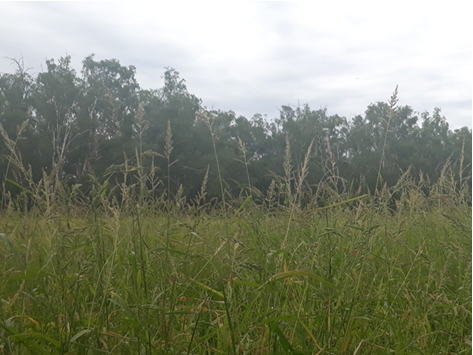Key points:
- Winter pasture legumes in rotation with drill sown rice can limit barnyard grass establishment, growth, and seed production.
- Barnyard grass has been a major constraint in realising water productivity gains from drill sown rice.
- Proven strategies for managing barnyard grass could encourage further adoption of aerobic rice production.
- Pasture legumes should be used in conjunction with other weed management tools and strategies for the best management of barnyard grass.
Barnyard grass, an annual summer grass weed in Australia, competes with the establishment of rice in the water efficient drill sown rice system, causing rice yield losses and quality issues. Yield losses of up to five tonnes per hectare have been reported due to barnyard grass, and it’s estimated that the weed can remove up to 80% of soil mineral nitrogen.
For Charles Sturt University PhD graduate, Dr Jhoana Opena investigating management methods for barnyard grass was an important strategy to assist Australia’s rice industry to adapt to climate challenges.
“Barnyard grass is a major constraint as growers shift to water saving strategies in rice,” she said. “The problem is in these systems, such as drill sown rice and delayed permanent water, barnyard grass proliferates – it grows really well.”
Found in 61 countries and growing as a weed in 36 different crop types, Jhoana said barnyard grass was also reported to have developed herbicide resistance to nine herbicide modes of action in 20 countries and four different crops.
Controlling barnyard grass with herbicides is estimated to cost $400-$870 a hectare, eroding farm profit.
Seeking an alternative control method, Jhoana observed that some New South Wales Riverina ricegrowers who were using pasture legumes in rotation with drill sown rice were successfully managing their barnyard grass seedbank. But there was limited literature on the inclusion of pasture legumes in the rotation to suppress weeds and the factors that contribute to the germination of barnyard grass.
Jhoana’s research, funded by the AgriFutures Australia Rice Program and supported by Charles Sturt University, Rice Research Australia Pty Ltd (RRAPL) and the Ricegrowers Association of Australia (RGA), set out to demonstrate the effectiveness of this strategy, outline best practice and how suppression with pasture legumes could be integrated with other weed management tools.
Conducting her trials at the University farm, Jhoana found that including at least two rotations of pasture legume species with other weed management tools and strategies gradually depleted the barnyard grass seed bank.
Over time winter pasture legumes had the most significant positive effect against barnyard grass compared with other rotation species in rice-based systems, such as winter crops or fallow.
“But for optimal results it [pasture legume rotations] must be combined with a no-till system,” Jhoana said. “In no-till systems the barnyard grass seeds remain on top of the soil, and this enhances the decay of the barnyard grass seeds as well.”
Seed bank depletion resulted from minimising grass seed set prior to sowing rice, reduced emergence due to sowing into mulch, and allelopathic suppression – the release of toxic chemicals. Allelopathic suppression reduced seed viability and inhibited growth.
“The best results can be achieved from using allelopathic pasture legume species or cultivars in combination with different weed management practices such as no-till, the stale seedbed technique, delayed sowing of rice and using sowing implements with minimal soil disturbance, such as discs,” she added.
Jhoana concluded that tackling barnyard grass with a combination of techniques, tools and strategies is vital to controlling the ecotype found in the drill sown rice area of south-east Australia.
She also found that barnyard grass is sensitive to shading and that sowing a weed competitive rice cultivar with early vigour could hinder the early development of barnyard grass.










